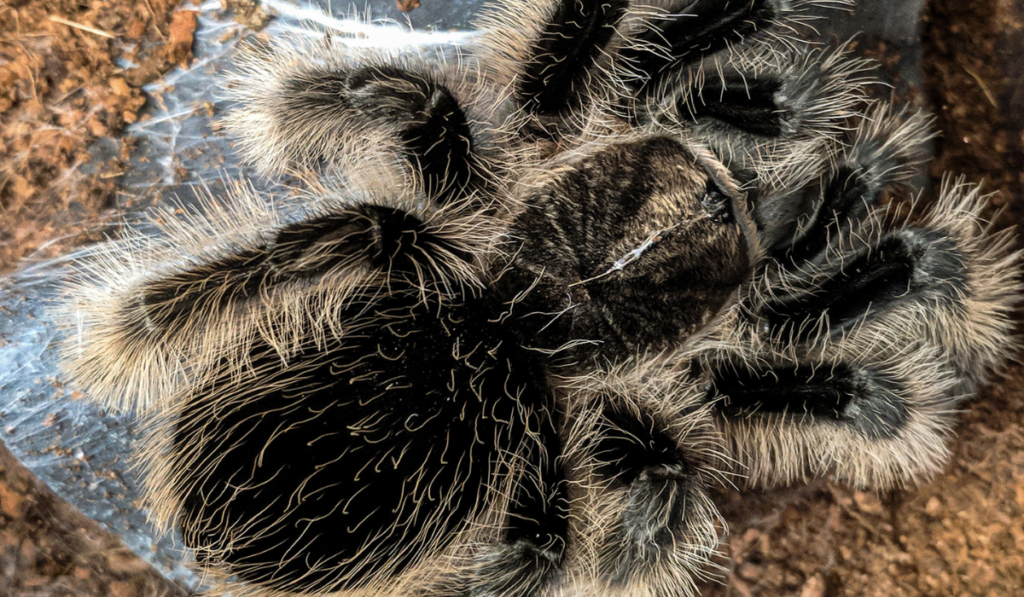Looking for a beginner-friendly tarantula that’s both beautiful and low-maintenance? Meet the Curly Hair Tarantula (Tliltocatl albopilosus), a fuzzy favorite among tarantula keepers. Known for their docile nature and unique curly hairs, these terrestrial arachnids are perfect for those new to the tarantula-keeping world. Whether you’re here to learn about their care or just admire their charm, this guide has everything you need to get started!
Species Overview
Scientific Name: Tliltocatl albopilosus (formerly known as Brachypelma albopilosum)
Common Name: Curly Hair Tarantula
Adult Size: +/- 6 inches
Life Span: Males +/- 5 years, Females +/- 25 years
Other Info: Terrestrial, New World Tarantula that’s a great beginner species!
In the above video I’ll show you everything you need to know before getting a Curly Hair Tarantula! Or, keep reading below to learn more about their care.
The T. albopilosus is an amazing tarantula species, and it is the first spider for a lot of people because of its wonderful and docile temperament. Plus, look how fuzzy they are! Their curly hair makes them look like little teddy bears.
The Tliltocatl albopilosus are New World, terrestrial tarantulas that are endemic to Costa Rica, Honduras and Nicaragua. Their curly hairs not only give them their name, but also serve as a defense mechanism. Like other New World tarantulas, they can flick urticating hairs if threatened, though this species is generally calm.
This tarantula has been popular in the pet trade since the 1980s, and used to be imported en-masse. In fact, imports of this species became so widespred that it was added to the C.onvention on I.nternational T.rade in E.ndangered S.pecies list – CITES controls which animals are legal and illegal to take from the wild. Since being added to the CITES list, virtually all curly haired tarantulas are bred in captivity, and can be bought easily at your local pet store or tarantula breeder.
Enclosure Setup
Size:
3-5 gallon glass or plastic enclosure with more floor space than height to reduce fall risks.
Substrate:
This species is an obligate burrower, and requires 5+ inches of suitable substrate. You can use topsoil, eco earth, a pre-made tarantula substrate and more to give your pet adequate burrowing opportunity.
Hides and Decor:
Provide hides such as cork bark, driftwood, or reptile-safe decor for your tarantula to have a safe place to hide. While your tarantula will likely create its own burrow, providing pre-made hides ensures comfort and enrichment.
Ventilation:
Proper ventilation is needed to prevent mold. Make sure your enclosure closes securely and does not have any big gaps that your pet could escape from.
Temps and Humidity
Temperature:
70-80°F (21-27°C). This species does great at room temperature, as long as night time temps don’t drop below 68 degrees.
Humidity:
This tarantula does not have strict humidity requirements. Occasionally mist the substrate in your enclosure, or overfill the water dish so some moisture can get down into the substrate. This gives your tarantula the option to burrow deeper for more humid conditions, or staying towards the top for more arid humidity.
Feeding and Diet
Feed your tarantula a variety of insects to raise a healthy and happy pet. Gut loaded insects such as dubia roaches, crickets, mealworms all make good staple feeder options. Adult tarantulas can be fed every 1-2 weeks, while juveniles should eat every 4-5 days. Prey size should never exceed the size of your tarantula’s abdomen to avoid injury.
Temperament & Personality
Tliltocatl albopilosus are known for being docile and slow-moving, making it a good choice for beginner tarantula keepers. They are generally very relaxed, and rarely show a threat pose. Adults spend a lot of their time out on display, however they may kick urticating hairs if they are stressed or threatened. Handling this species is possible, especially if you get them used to it from a young age. Limit handling time due to the risk of falls or injury.
Cleaning & Maintenance
Uneaten prey and feces should be removed regularly. Change the substrate and do a full enclosure cleaning every 6 months, or when the enclosure appears dirty.
Curly Hair Tarantulas are more than just adorable—they’re ambassadors for the amazing diversity of arachnids. Ready to welcome one into your life? Start by learning all about their care in my YouTube video linked above, and don’t forget to subscribe for more tarantula and exotic pet content! 🕷️



